
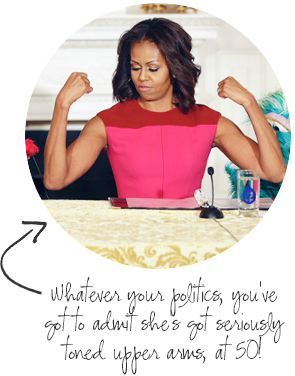
I used to have upper arms that put Michelle Obama’s to shame, and I didn’t even lift weights. Know why? I was 40!
Well, ladies, I will never again see 40 and my upper arms will never again see the light of day.
The simple reason our underarms—as well as a number of other areas on our bodies—get flabbier as we age, is because our skeletal muscle mass starts to degenerate. The striated muscle tissue that is attached to bones, skeletal muscle is made of fibers that look like a mixture of dark and light bands bundled together and running along the bone. Our central nervous system regulates the activity of all muscles in our body. When we voluntarily decide to move, these muscles are responsible for contracting and relaxing. Skeletal muscles 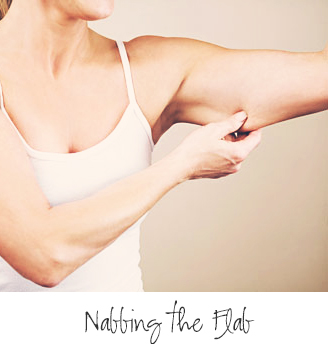 work together with bones to give us power and strength. We can see and feel these muscles through our skin, but once they start to deteriorate, we see mostly flab. Plus, we become less powerful and weaker. YICH!
work together with bones to give us power and strength. We can see and feel these muscles through our skin, but once they start to deteriorate, we see mostly flab. Plus, we become less powerful and weaker. YICH!
Although changes to our skeletal muscle mass may begin when we’re in our 30s, most of us see the biggest changes in our 40s and 50s. On average, we lose about 30 percent of our strength between ages 50 and 70, and another 30 percent of what’s left per decade after that.
Other notable muscular changes include:
- Increased response time for our muscles to react to brain signals when we’re in our 50s than they did in our 20s. As a normal course of aging, we begin to lose the muscle fibers that are responsible for making us move quickly. The speed of transmission of impulses from the brain to the muscles also slows down, so it takes longer to get the signal, “Hey! Move it!” Our muscles also can’t repair themselves as quickly as they used to, due to a decrease in enzyme activities and protein turnover.
- The water content of tendons (the cord-like tissues that attach muscles to bones) decreases as we age. This change makes the tissues stiffer and less able to tolerate stress.
- Heart muscle becomes less able to propel large quantities of blood quickly through our bodies. As a result, we tire more quickly and take longer to recover.
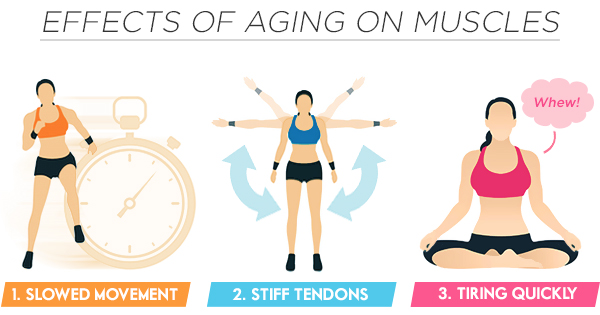
Yes, Virginia, You Can Bring Back Your Muscle!
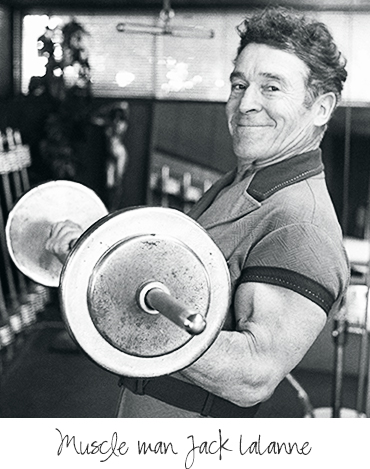
Now that you’ve heard the not-so-good news, here is the GOOD NEWS: Fortunately, muscle weakening (called atrophy), while a natural process, doesn’t have to be inevitable. You can get this muscle back with a strength- training routine (lifting weights and working out).
Remember Jack LaLanne, the “godfather of fitness” who had muscles of merit till the day he died, at 97? Decades before celebrities like Jane Fonda and Richard Simmons started promoting health and fitness, LaLanne was already widely recognized for publicly preaching the health benefits of regular exercise and a good diet. While we don’t have to become fitness fanatics like LaLanne, he remains a stunning example of our ability to keep our muscles strong.
So if you find yourself becoming more sedentary with each succeeding birthday, get off the
sofa and start moving.
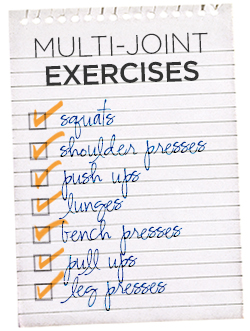
There are a gazillion articles and videos on the Internet, filled with fitness advice and demos of exercises that target your chest, shoulders, biceps, abs, back, hips, glutes and quads, hamstrings and calves, each a distinct “muscle group” requiring distinct exercises. “Multi-joint exercises” work more than one muscle group at the same time. Squats, lunges and leg presses, for example, build the glutes, quads and hamstrings, all in one exercise. Women 50+ should typically choose multi-joint exercises versus exercises that isolate one muscle, since they improve stability, balance and coordination and can help you avoid injuries when doing other types of exercise. Push ups, pull ups, bench presses and shoulder presses are other types of multi-joint exercises. It’s best to first get clearance from your doctor before starting a regimen, then consult with a fitness professional to determine which exercise plan is best for you.
Feeding Your Muscles
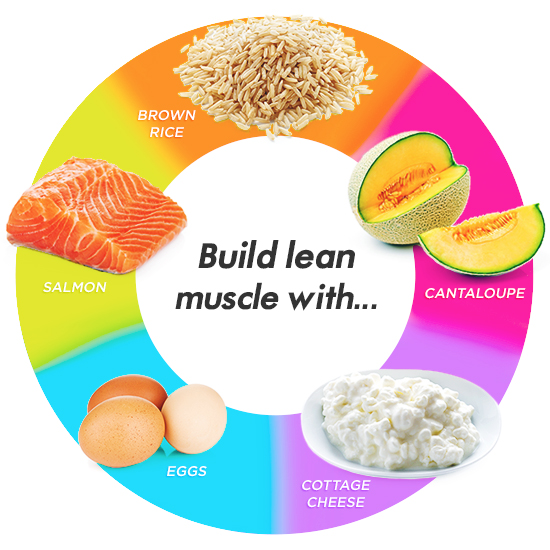
Eating right can also help build lean muscle. While the overall calorie, protein, carbohydrate and fat content of your diet—rather than specific foods—determines the amount of muscle you’ll gain, protein-rich foods, whole-grain carbs and healthy fats will make a greater impact. These include:
- BROWN RICE: This is slow-digesting whole grain that provides longer-lasting energy throughout the day, and during workouts. It also encourages lean muscle growth, fat loss and strength gains.
- CANTALOUPE: Relatively low in fructose, this melon is one of the few fruits that is actually a fast-digesting carb, which makes it good to eat first thing in the morning, as well as after workouts.
- ORGANIC COTTAGE CHEESE: An excellent go-to protein source, especially before bed. High in casein protein(the slowest-digesting protein you can eat), it prevents your muscles from being used as an energy source while you fast during the night.
- EGGS: Known as the perfect protein, eggs boost lean muscle and strength. Their yolks also aid the muscle-building process. Believe it or not, the cholesterol from eggs has been shown to decrease the amount of LDL (bad) cholesterol particles associated with atherosclerosis.
- SALMON: Salmon is potentially a better muscle-building protein than a low-fat fish, such as tuna or cod, because it’s higher in calories. These extra calories are ideal if you’re active and looking to build muscle.
While exercising and eating properly are the tenets for staying fit and healthy, we can’t always do exactly what we should. Ensure, a brand that has been specifically addressing adult nutrition needs for over four decades, says it can help us stay on course and wants us to think of it as our own personal nutritionist. Its new line of Ensure Active shakes and drinks is designed to help “active adults stay healthy and energetic” by meeting our most important 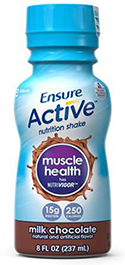 nutritional needs and health goals.
nutritional needs and health goals.
One of its new nutrition shakes, Ensure Active Muscle Health, is specially formulated to help rebuild muscle lost over time, and help us gain our strength. Available in tasty milk chocolate, vanilla and strawberry, the shake has 250 calories; Nutrivigor, (a source of HMB, an amino-acid metabolite that helps prevent protein breakdown), and 15 grams of protein. It’s also low in saturated fat.
Provided we’re exercising and eating properly, it looks like Ensure Active Muscle Health would be just what the company claims: “An excellent choice for an occasional breakfast, lunch or as a between-meal snack.”
Ensure partnered with bloggers such as me for its Ensure Active blogger program.
As part of this program, I received compensation for my time. Ensure believes that consumers and bloggers are free to form their own opinions and share them in their own words. Ensure’s policies align with WOMMA Ethics Code, Federal Trade Commission (FTC) guidelines and
social media engagement recommendations.

